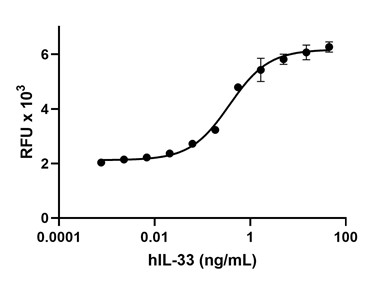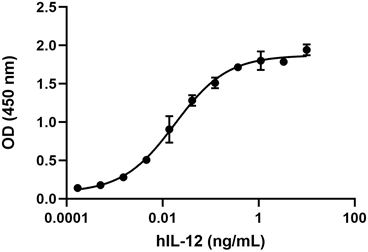- Regulatory Status
- RUO
- Other Names
- Thymic stromal lymphopoietin (TSLP)
- Ave. Rating
- Submit a Review
- Product Citations
- publications

-

Baf3-hIL7a/hTSLPR cell proliferation induced by human TSLP.
TSLP was initially identified in conditioned medium from a mouse thymic stromal cell line. Human and mouse TSLP are only 43% identical at the amino acid level, and TSLP, like IL-7, exhibits species-specific functions and may function differently in humans and mice. TSLP binds to a heterodimeric receptor constituted by IL-7Ra and TSLPR. TSLPR has low affinity for TSLP, but in combination with IL-7Ra generates a high affinity binding site. TSLP has been associated with the development of allergic disorders in humans, such as asthma, atopic dermatitis, and food allergies. The susceptibility to allergic diseases has been associated to basophil induction by TSLP, and Th2 cytokine production induced by TSLP in mast cells. In addition, TSLP has been associated to the development of Tregs, and blocking TSLPR leads to delayed functional maturation of thymic Tregs. TSLPR has been detected in Tregs from allergic asthmatic patients. TSLP directly activates STAT5 in Tregs and suppresses its suppressive activities; additionally, it inhibits IL-10 production. Human TSLP induces the release of T cell-attracting chemokines (CCL17 and CCL22) from monocytes and enhances the T cell stimulatory capacity of the CD11c+ subset of dendritic cells. TSLP induces proliferation of naïve T cells. In addition, it can drive Th2 differentiation via the induction of IL-4 production, and drives Th2 cytokine-mediated inflammation by acting on bone marrow-resident progenitors, which promotes basophil hematopoiesis. TSLP is upregulated in epithelial cells by IL-1α, TNFα, and Th2 cytokines.
Product DetailsProduct Details
- Source
- Human TSLP, amino acids Met-Tyr29-Gln159 (Accession# AF338732), was expressed in E. coli.
- Molecular Mass
- The 132 amino acid recombinant protein has a predicted molecular mass of approximately 15 kD. The DTT-reduced protein migrates at approximately 17 kD and non-reduced protein at approximately 18 kD by SDS-PAGE. The N-terminal amino acid is Met.
- Purity
- >98%, as determined by Coomassie stained SDS-PAGE.
- Formulation
- 0.22 µm filtered protein solution is in 20 mM NaH2PO4, pH 7.2, 0.15 M NaCl.
- Endotoxin Level
- Less than 0.01 ng per µg cytokine as determined by the LAL method.
- Concentration
- 10 and 25 µg sizes are bottled at 200 µg/mL. 100 µg size and larger sizes are lot-specific and bottled at the concentration indicated on the vial. To obtain lot-specific concentration and expiration, please enter the lot number in our Certificate of Analysis online tool.
- Storage & Handling
- Unopened vial can be stored between 2°C and 8°C for up to 2 weeks, at -20°C for up to six months, or at -70°C or colder until the expiration date. For maximum results, quick spin vial prior to opening. The protein can be aliquoted and stored at -20°C or colder. Stock solutions can also be prepared at 50 - 100 µg/mL in appropriate sterile buffer, carrier protein such as 0.2 - 1% BSA or HSA can be added when preparing the stock solution. Aliquots can be stored between 2°C and 8°C for up to one week and stored at -20°C or colder for up to 3 months. Avoid repeated freeze/thaw cycles.
- Activity
- ED50 = 0.4 - 2.4 ng/ml, as determined by the dose dependent stimulation of mouse BaF3-human IL-7a and human TSLPR cotransfectant cell proliferation.
- Application
-
Bioassay
- Application Notes
-
BioLegend carrier-free recombinant proteins provided in liquid format are shipped on blue-ice. Our comparison testing data indicates that when handled and stored as recommended, the liquid format has equal or better stability and shelf-life compared to commercially available lyophilized proteins after reconstitution. Our liquid proteins are verified in-house to maintain activity after shipping on blue ice and are backed by our 100% satisfaction guarantee. If you have any concerns, contact us at tech@biolegend.com.
Antigen Details
- Structure
- Cytokine
- Distribution
-
Epithelial cells, mast cells, basophils, epidermal keratinocytes in atopic dermatitis, synovial fibroblast in arthritis rheumatoid, human airway smooth muscle cells
- Function
- Induces proliferation of naïve T cells, the release of T cell-attracting chemokines (CCL17 and CCL22) from monocytes, and the T cell stimulatory capacity of CD11c+ subset of dendritic cells; drives Th2 differentiation, drives Th2 cytokine-mediated inflammation to promote basophil hematopoiesis
- Interaction
- Monocyte, dendritic cells, activated human basophils, activated human T cells, Langerhans cells, B cells, mast cells, activated pulmonary Tregs, NKT cells
- Ligand/Receptor
- Heterodimeric receptor complex composed of the IL-7 receptor α chain (IL-7Rα) and the TSLP receptor (TSLPR or CRLF2)
- Biology Area
- Cell Biology, Immunology
- Molecular Family
- Cytokines/Chemokines, Growth Factors
- Antigen References
-
1. Levin SD, et al. 1999. J. Immunol. 162:677.
2. Reche PA, et al. 2001. J. Immunol. 167:336.
3. Omori M and Steven Ziegler. 2007. J. Immunol. 178:1396.
4. Rochman I, et al. 2007. J. Immunol. 178:6720.
5. Mazzuchelli R, et al. 2008. Blood 112:3283.
6. Siracusa MC, et al. 2011. Nature 477:229.
7. Nguyen KD, et al. 2010. Allergy Asthma Clin. Immunol. 6:4. - Gene ID
- 85480 View all products for this Gene ID
- UniProt
- View information about TSLP on UniProt.org
Related FAQs
- Why choose BioLegend recombinant proteins?
-
• Each lot of product is quality-tested for bioactivity as indicated on the data sheet.
• Greater than 95% Purity or higher, tested on every lot of product.
• 100% Satisfaction Guarantee for quality performance, stability, and consistency.
• Ready-to-use liquid format saves time and reduces challenges associated with reconstitution.
• Bulk and customization available. Contact us.
• Learn more about our Recombinant Proteins. - How does the activity of your recombinant proteins compare to competitors?
-
We quality control each and every lot of recombinant protein. Not only do we check its bioactivity, but we also compare it against other commercially available recombinant proteins. We make sure each recombinant protein’s activity is at least as good as or better than the competition’s. In order to provide you with the best possible product, we ensure that our testing process is rigorous and thorough. If you’re curious and eager to make the switch to BioLegend recombinants, contact your sales representative today!
- What is the specific activity or ED50 of my recombinant protein?
-
The specific activity range of the protein is indicated on the product datasheets. Because the exact activity values on a per unit basis can largely fluctuate depending on a number of factors, including the nature of the assay, cell density, age of cells/passage number, culture media used, and end user technique, the specific activity is best defined as a range and we guarantee the specific activity of all our lots will be within the range indicated on the datasheet. Please note this only applies to recombinants labeled for use in bioassays. ELISA standard recombinant proteins are not recommended for bioassay usage as they are not tested for these applications.
- Have your recombinants been tested for stability?
-
Our testing shows that the recombinant proteins are able to withstand room temperature for a week without losing activity. In addition the recombinant proteins were also found to withstand four cycles of freeze and thaw without losing activity.
- Does specific activity of a recombinant protein vary between lots?
-
Specific activity will vary for each lot and for the type of experiment that is done to validate it, but all passed lots will have activity within the established ED50 range for the product and we guarantee that our products will have lot-to-lot consistency. Please conduct an experiment-specific validation to find the optimal ED50 for your system.
- How do you convert activity as an ED50 in ng/ml to a specific activity in Units/mg?
-
Use formula Specific activity (Units/mg) = 10^6/ ED50 (ng/mL)

 Login / Register
Login / Register 














Follow Us